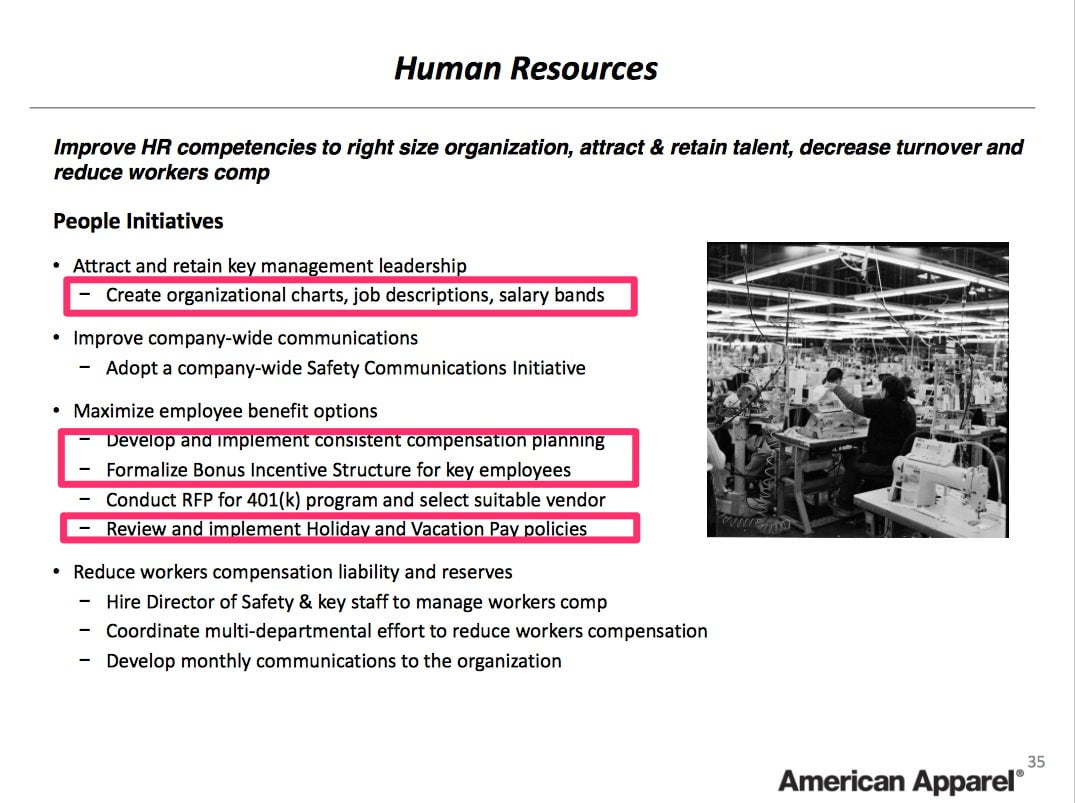American Apparel’s new CEO is taking the company back to (management) basics
Dov Charney is not an easy act to follow for new CEO Paula Schneider. In addition to being the iconic founder of the brand, he’s left the company in dire financial straits, and continues to embroil it in a legal morass.


Dov Charney is not an easy act to follow for new CEO Paula Schneider. In addition to being the iconic founder of the brand, he’s left the company in dire financial straits, and continues to embroil it in a legal morass.
He also apparently ran the company without many basic management functions. It lacked an organizational chart, for example—or at least one that was passed down to Schneider—to show which managers reported to whom. It meant that around 60 people directly reported to him, according to Schneider. The average number of direct reports for the CEO of a large corporation is about 10.
Here’s a telling slide from Schneider’s presentation to investors this week about her plan to turn the struggling retailer around. Note particularly that the plan includes moves to “create organizational charts, job descriptions, salary bands,” to “formalize a bonus incentive structure for key employees,” and to “review and implement holiday and vacation pay policies,” all of which strongly suggest that these things barely existed, if at all, before:

Asked about the slide, Schneider confirmed the absence of a structure. (Although in fairness to Charney, if he had one, he wouldn’t have had much time to share it with Schneider, as the two didn’t have much time for torch-passing.)
“Yeah, traditional org charts were simply not there,” Schneider told Quartz. “As far as who reported to whom, when I was trying to figure out who reported to me there was probably 60 people that reported directly to Dov.”
Fixing that is particularly important as Schneider works to change the business.
“Dov is one of the hardest working people on the planet, but it’s really hard to scale that,” she told Quartz. “I need people that are going to lead their areas because I don’t have all of the knowledge. I didn’t create the company. I’m learning. But regardless, I believe from a scalability standpoint you have to have leaders who run their own business.”
Just five months into her tenure, she’s still finalizing the org chart. And there’s plenty of work to be done on other basics, like salary bands to define what certain positions or seniority levels get paid, and even giving people time off in a consistent way.
“We do not have any salary bands,” Schneider said. “We are lacking in a lot of the employee benefits other companies have. We just established the first four paid holidays ever.”
Pay structure was also not terribly well-delineated.
“I don’t know exactly what transpired. I know people got bonuses beforehand, but… there weren’t objectives [laid out] to get there,” Schneider said. “There wasn’t any paperwork that could show me what people had received in the past and why.”
Schneider is putting in a more rigorous system where, for top management at least, either the whole team hits the target and gets a bonus, or nobody does. While people go back and forth on how much hierarchy or how many layers of management are best at a company, when it comes to things like compensation and benefits, transparency and consistency is definitely viewed as better.
And limiting the number of direct reports to a CEO not only frees them up to think strategically, it gives other executives more autonomy and ownership.
Of course, simply building a management structure isn’t a panacea. It’s one part of an extensive turnaround plan that includes significant cost cutting, product investment, hiring fresh talent, and restructuring. She’s introducing a zero-based budgeting process for example, which the company never had before, and she’s rethinking the company’s approach to merchandizing, advertising and retailing. Still Schneider seems extremely confident in her plan, which aims to turn American Apparel from a $600 million into a billion dollar business.